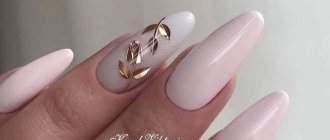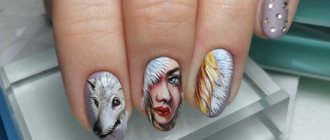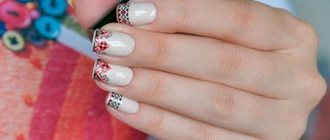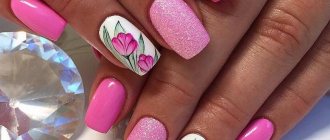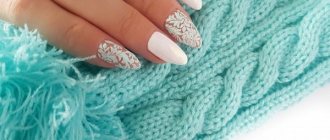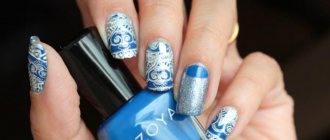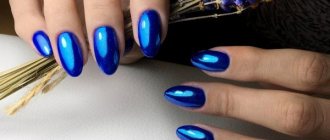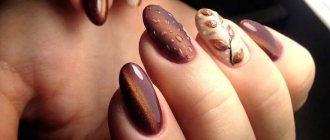Watercolor manicure is an all-time trend. He always looks unusual, interesting and very gentle. It seems as if an artistic canvas has been recreated on the nails! This nail design is suitable for girls with good taste who do not like to be in the shadows.
The big advantage of watercolor prints is that they are relevant at any time of the year: warm colors and fruit patterns can predominate in the summer, yellow-orange shades, leaves and berries in the fall, cold colors and airy winter images in the winter, and any flowers in the spring. ! Also, using watercolor techniques you can create amazing weightless compositions.
Do you want to learn this type of manicure?
Then read our article - it contains step-by-step instructions! Watercolor manicure is an all-time trend
What is watercolor painting in manicure
Watercolor painting on nails is done with acrylic, watercolor or gel paints, as well as watercolor pencils and gel polish.
The application technique depends on the chosen material. The basis of the design is predominantly white, but there may be others - nude, pale pink, pale blue, pale lilac. In addition to pastel shades, nail artists today also offer designs on black gel polish, made in white and light colors. But this design requires single-color or two-color painting (two colors.
A pattern is applied to the matte surface of the nail coated with gel polish. If the base is shiny, wipe it with a buff. This way the paint spreads better and does not roll off.
Attention! The peculiarity of watercolor manicure is the absence of clear boundaries in the drawing. The picture is light and airy.
Some masters often offer this style in the summer, when you want lightness and ease. Soft and calm tones go well with bright summer dresses.
Watercolor nail design offers many variations of different designs, suitable for both everyday manicure and for a special event or a romantic evening.
General recommendations
In the process of mastering the technique, many beginning masters have questions. Is it possible to draw only with a certain method or are some deviations allowed?
The design can be chosen to suit your taste. But watercolor does not allow many liberties in the order of actions at the time of design. It’s better to draw the picture on your nails step by step so that you get a nice design in the end.
Attention! When painting on nails with watercolors, a matte finish is used. Gloss won't work. Even if it was taken from a quality brand.
When choosing colors, it is better to limit yourself to flesh, light or dark tones. You should not abuse other colored paints, which can spoil the displayed ornament. Red, flashy or saturated bases can significantly damage the integrity of the design.
Otherwise, if all conditions are met, a watercolor composition can turn out beautiful and memorable.
Techniques for painting nails with watercolors
To make a manicure look good on your hands, you need to master the correct techniques for creating a watercolor design.
These include:
- Wash. Thanks to this technique you can create bright and colorful flowers. A pastel shade is applied to the nails, which must be heavily diluted with water. After the first layer has dried, apply the second and third. Consequently, the midtones will become deeper. Attention! There is no need to apply a fourth coat.
- Wet. Stain is carefully applied to the paint layer that has not yet dried, which can be done several times. The main thing to note is the very smooth transitions for which this manicure was created. If you need to intensify the color in some areas, you should also use the brush on a "wet" layer.
- Monochrome staircase. In any situation, designs made in one color look advantageous on nails. This type of work is quick and easy to do, and the result will please you for a long time. First you need to draw the outlines and let them dry a little. Next, you need to moisten the brush in water and fill the internal spaces. At the end of the work, draw the outlines again for greater clarity. Abstract patterns look great in this technique.
- Colored glass. The principle of performing the technique is very similar to that mentioned above. The key difference is that stained glass is difficult to imitate, requiring mica and the use of a color palette in some works.
- Watercolor gel polishes on French nails. The typical French manicure, already loved by fashionistas, has been reworked by masters: now it is used as a canvas for watercolors. Moreover, the result is very interesting.
- White watercolor strokes. To perform this technique you will need a flat brush and white watercolor. Apply a little white polish to the edge of the nail. You can also use a medium sized brush and make small strokes to change the background of the image.
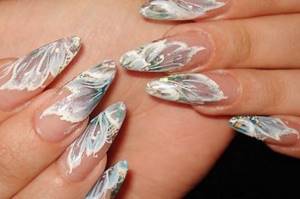
- Blur with a flat brush. Floral design can be complemented by the amazing property of watercolor to blur even with a small amount of water. To do this, you need to take the desired shade and shadows with a brush. This way you can achieve a color change.
- Double strike technique. Ideal for drawing three-dimensional flowers that combine different shades. The execution process is very simple: 2 colors are applied to the brush, which do not mix with each other. And with each contact with the nail, a double stroke is obtained, consisting of several highlights at the same time.
Creating monograms
This design method is quite popular because it does not require special preparation. Most experts advise painting a pattern on one or two nails and covering the rest with a single-color gel polish. This will create a brighter accent.
Thin patterns are easier to paint with acrylic paints.
Monogram pattern
There are several ways to apply manicure:
- When stamping, we use a stencil on which we paint with gel polish. For beginners, this technique is quite convenient because it does not require special skills. However, nothing can be added to the design;
- monograms can be painted using a thin brush. In this case, you will need perseverance, since if there is the slightest deviation from the pattern, the pattern will have to be applied again. But in this case, your imagination is not limited;
- The easiest way is to use stickers. They just need to be pressed onto the nail and then secured with a finishing layer.
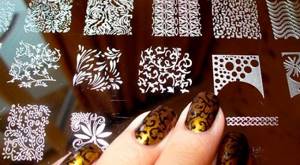
Stencil for applying monograms
To draw a monogram, place dots on your nails and use the sharp end of a needle or brush to stretch them in the desired directions.
The photo shows patterns that you can easily reproduce at home.
Drawing a pattern
Materials for watercolor manicure
To create a watercolor manicure we may need:
- Watercolor gel polish: medium density, easy to apply to the nail plate. Additionally, once propagated, it maintains edge precision and richness.
- A special base for it facilitates easy application and better hardening of the composition. This is important if we want to create simulated drops and dots.
- Watercolors - can be used for both abstract and detailed patterns. Due to the fact that they are water-based, the paints dry in 1-2 minutes, and this is the optimal time. It is enough to create the desired image without waiting for the material to harden to continue working with the design. And the end result is simply covered on top.
- Acrylic paints: Still popular, especially among beginners who find it difficult to reproduce the perfect design in a couple of minutes. You can work with acrylic for much longer.
- Brushes of different thicknesses and hardness. You will need both manicure tools and art tools for working with watercolors.
Watercolor gel polish
These paints are regular gels in bottles with a brush. Their peculiarity is a chemical formula that allows the interaction of pigments of different shades. Spreading over the surface of the nail, they create patterns. A few drops are scattered throughout the composition, visually reminiscent of the skin of a flower or reptile. This depends on the size, location and volume of the drop.
The material polymerizes under the influence of ultraviolet rays.
Acrylic paint
This material is a pigment (usually available in tubes) for coloring. The paint is applied to a matte surface, dries in the open air, and dissolves in water. Acrylic paints diluted with water have the slowest drying speed. In practice, nail technicians rarely use acrylic paints for watercolor painting. Their density is best suited for Chinese painting using flat brushes with an angled angle.
Paint for painting “Watercolor drops”
This is a colored liquid in a bottle with a brush. The base is an alcohol solution. Thanks to this feature, they have a high drying rate on the surface and do not require polymerization. The liquid has a narrow palette (usually no more than 10-15 colors). However, mixing shades can produce new colors.
You can create chaotic designs and textures with a bottle brush without using additional tools.
Gel polish
This is a colored varnish that requires polymerization in a lamp. It can have varying degrees of pigment density depending on the manufacturer and the effect. The material has a wide range of shades and is often used for painting. Watercolor painting of nails using conventional gel polishes is performed in stages with intermediate drying of each applied layer. Otherwise, the pigment will mix and create a messy appearance.
This technique is considered the most difficult, since to create light and shade it is necessary to dilute the densely pigmented gel polish with a top coat or its other shades. You can simplify the task using special stencils.
Preparation stage
Before applying the design, you will need to prepare the nail for the process. This takes its own time. Most often, masters highlight it as a preparatory stage.
Having decided what kind of manicure or its ornament will be, you should prepare a base for it. The nail “canvas” is designed as follows:
- Remove the covering if present. Set the desired shape and length. Treat hangnails and cuticles.
- Remove glossy shine from the surface.
- Apply base coat, followed by varnish. You can secure it with a top coat.
- After the layers have dried in the lamp, the nail is roughened.
Upon completion of these steps, the nail will be ready to apply the image.
Tip: each layer must be heated in a lamp for deep drying so that the varnish adheres well. And the drawing was clear.
Pros and cons of coatings with a spreading effect
For ease of comparison, lists of the main pros and cons of watercolor gel paints are grouped in one table:
| pros | Minuses |
| Quick and easy to use | Inability to control the distribution of material |
| Similarity in chemical formula to other materials used for leveling and molding, therefore better adhesion and durability. | A short list of designs that can be created. It is not possible to create complex and realistic images. |
| Easy to store packaging | The material is only suitable for this technique |
| No water is used for dilution, which reduces the quality of adhesion between the model and the upper. | The shade cannot be changed, as when diluted the material may lose its properties. |
| After hardening, there is no risk of erasing (blurring) the design if it is covered with a top coat. | High cost compared to other materials, fast consumption. |
| Does not require activation or additional preparation. The material is ready for use immediately after opening the bottle. | Limited palette |
Removing moisture
This technique will require several sponges. It is suitable for depicting clouds and soft light. It can also control the behavior of paints.
Sponges
Makeup sponges are best. They absorb well and give an interesting effect.
Try not to rub the sponge on the paper, and if you do, do it very carefully so as not to damage the paper. Paper towels
Paper towels
With their help you can create sharper highlights. But paper towels absorb huge amounts of paint very quickly. Therefore, they can completely absorb fresh paint.
Paper towels can come in handy if you make a mistake. Then you can quickly remove the paint.
Dry brush
You can use a dry brush to create a design using this technique. To do this, rinse thoroughly and squeeze out the brush. With its help you can create clear lines.
Other methods:
- You can spray water where you want to remove the paint and then soak it up with a sponge.
- Use different fabrics to add texture
- You can use your fingers or other body parts. Skin can also absorb moisture.
Color combinations of manicure with stains
Black manicure with streaks
Black is another safe bet for a striped manicure. It pairs easily with any color and can be a great addition to any look. This design looks very unusual and attractive due to the effect of a slight haze formed on the dark surface.
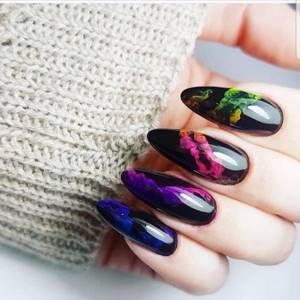
White manicure with streaks
To create such a design, white gel polish is used as a basis, and any other shades are used for stains. One of the most popular options is black stripes on a white background.
A white manicure with spots will suit any look. Depending on the color, you can get both everyday manicure and holiday designs.
Sealing or securing
The final stages play a significant role in the final look of the manicure. They should be given no less attention than composing the composition.
Tips for consolidation that may be useful at the end of all stages:
- To seal, you can use a two-in-one top or a regular rubber top.
- If you used rubber, you will have to reapply a regular gel polish topcoat. This will maintain the durability of the coating and healthy shine.
- A top with a two-in-one effect does not require re-coating.
- Do not forget about removing the dispersion layer after drying in the lamp.
Manicure design with watercolors
Floral design
Roses painted in one color look perfect against a dark background. They can be decorated with rhinestones or bouillons. We draw the petals from a point in the center or in the reverse order, pulling out each petal with a thin brush. Poppies, daisies, dandelions, and irises look beautiful in this style.
Marine theme
The tones are predominantly blue-green. Drawing is simple: randomly apply dots on the substrate and let it spread unhindered. You can decorate with an applique: an anchor, a fish, a ship, a shell, a starfish or a horse.
Reptile skin
The color scheme here can be varied: shades of green, blue, pink, gray. They usually combine two colors that match the tone, creating the natural color of the reptile's skin: yellow and orange, gray and black. The design is applied in the same way as the marine theme, but in a checkerboard pattern.
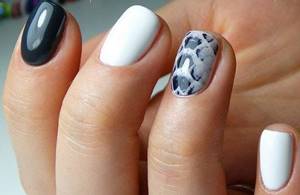
Abstract pattern
Here the designer’s imagination has nowhere to go. You can depict curls, chaotic lines, circles of different diameters. The color range is as wide as possible. The photo below is full of ideas for creating an abstract design.
Marble image
As with the reptile skin patterns, two shades of watercolor are used. These can be contrasting or similar colors. The “stone” motif is made rough or veined.
Animals
Cats, dogs, birds and fish are especially popular among fashionistas. They complement your everyday look well and lift your mood on weekdays. You can get ideas for drawing from children's books. Such models require high artistic talent from the master.
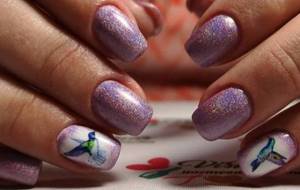
There are many design variations, it all depends on the imagination and talent of the nail artist. The more painstaking the work, the more skills and time it will take to create a unique image.
Drawing courses
Learning to paint with watercolors on your own is interesting, but terribly time consuming! When there is an experienced artist nearby who will help you see and correct mistakes, things will go much faster.
How to choose drawing courses so that they are effective and you do not waste your money? Answer yourself the question: “Why do I want to learn how to draw?”
If you are determined and want to reach the level of at least Michelangelo in order to enter a university or paint professionally, pay attention to academic drawing courses. Start by studying the program
What does the school want to offer you? Do you find it too easy or too difficult for your level?
Start by studying the program. What does the school want to offer you? Do you find it too easy or too difficult for your level?
Often, art schools break classes into thematic units such as “Fundamentals of Head Drawing” or “Tone Drawing.” On average, such blocks can last from 14 to 72 academic hours.
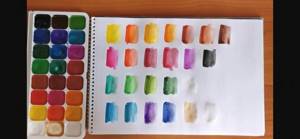
The cost will also be different: from 3,000 to 10,000 rubles.
If you are more interested in drawing as a hobby or want to master one or two techniques, pay attention to master classes. In a short period of time (2-6 hours), they will explain to you the basics of drawing in one technique or another and tell you step by step how to draw a picture that you will create right there in class.
The cost of master classes depends on the school and teacher and starts from 2,000 rubles.
Look at reviews of the school you have chosen
Pay attention to what students say about the general atmosphere. Drawing under stress is very difficult, because this is an activity for which you need to free your head and give free rein to your emotions and imagination
Watercolor manicure ideas: a few tips when working with watercolor paints
First of all, it is worth remembering that in order to turn one dark shade into several lighter ones, you should dilute it with white watercolor paints. Thus, all elements of the ornament will have their softness in transitions. But don’t get too carried away, otherwise the drawing will become too whitish and turn into a brightened landscape.
By applying the desired tone, you can work with the color scheme directly on the nail plate. A brush will be a great help for this. It is this that will add vagueness and help achieve the desired result. The thickness of the brushes may vary. It depends on the size of the image. If the design must fill almost all the nails, it is worth paying tribute to thicker brushes.
After finishing work on the ornament, you should not emphasize all the contours and elements of the ornament. This will give your work translucency and lightness. To get a watercolor effect, do not make the outline too thick and outline the entire ornament.
It is also worth choosing high-quality and professional brushes designed specifically for working with manicure watercolor paints. When creating a drawing, not all masters manage to draw straight lines. Therefore, it is necessary to take into account the main advice: the brush should be held perpendicular to the nail plate.
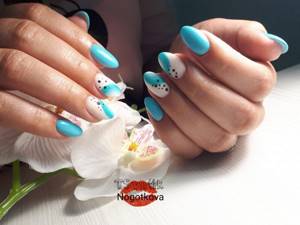
Watercolor painting of women's marigolds is simply mesmerizing in its appearance. After all, real masters are able to convey in a meager drawing the entire character and mood of the future owner of the manicure. It is this technology of decorating with marigolds that occupies a leading position in modern fashion. But, unfortunately, only a real professional is able to create a real landscape in the hands of women.
Basic exercises
The first few sheets in beginners' notebooks always look the same: vertical and horizontal stripes of different saturation with color transitions (blurs and shading). Having learned how to make monochromatic and fragmentary washes, you can move on to simple images outside the plot and composition - individual trees, houses, geometric shapes. To correctly convey chiaroscuro, it is enough to learn three transitions between colors, from light to dark or vice versa. At first, it is recommended to depict as many individual objects as possible, drawn from life or from memory.
Drawing school "Find Yourself"
The online course “Watercolor for Beginners” was created for those who want to learn all the intricacies of painting techniques with transparent paints.
Classes are suitable for beginners in drawing.
Even if you've never painted, you'll create some amazing DIY art and learn important techniques in this course. You will also learn how to work with tone and color, learn about perspective and composition. The teacher will tell you in detail about the features and stages of working with watercolors.
During the online course, in just 17 lessons, you will gain basic knowledge about watercolor painting, as well as get acquainted with the nuances of drawing in practice.
If you've never painted with watercolors, the hardest part is taking the first step. Teacher Valeria will tell you all the details of watercolor technique - you will receive high-quality feedback from a professional artist.
How do online watercolor courses work:
- View new lessons every week
- Do your homework
- Take photos of your drawings and send them
- Get feedback from the artist
Online course “I am an Artist”
Online course “Watercolor painting”.
This is a complete course in watercolor painting, developed on the basis of academic programs of leading art universities. No fuss and a minimum of theory, all 40 academic hours you will study the properties of materials, techniques and techniques, features of composition and choice of palette.
This course has answers to all the questions that a beginning watercolorist asks himself, sequentially, from simple to complex, you will learn everything you need. Well, continuing artists will be able to delve deeper into the properties of watercolor and learn to use even more possibilities of this paint.
You will work in techniques such as grisaille, glazing, wet painting; you will use salt, napkins, white gouache and much more. In other words, this is the perfect course to improve your watercolor skills at any level!
Practice awaits you from the very first lessons. You will learn about the properties of color and its capabilities, learn to apply the laws of composition and layout, light and shade and perspective in your work.
Daria Kutsaeva will talk about how to choose the best materials for the job. You will learn how to work with large amounts of water, how and why to use gauze, paper napkins, reserve, salt or white gouache.
Under the supervision of a teacher, you will paint still lifes, landscapes and even portraits in different watercolor techniques - 15 works in total! You will be working on composition and textures. Using various techniques, you can realistically convey all the features and details of the surrounding space: the rippling water surface, reflections in the water, the textures of wood, glass and wickerwork.
This is not just an online course in the usual “look and do” format, it is a whole complex of courses, master classes and personal communication with the teacher, created specifically to ensure that you are guaranteed to study all the necessary theory, master new techniques and consolidate the acquired knowledge on practice.
